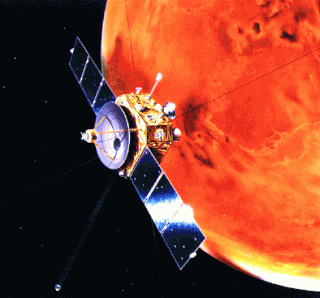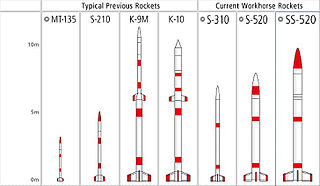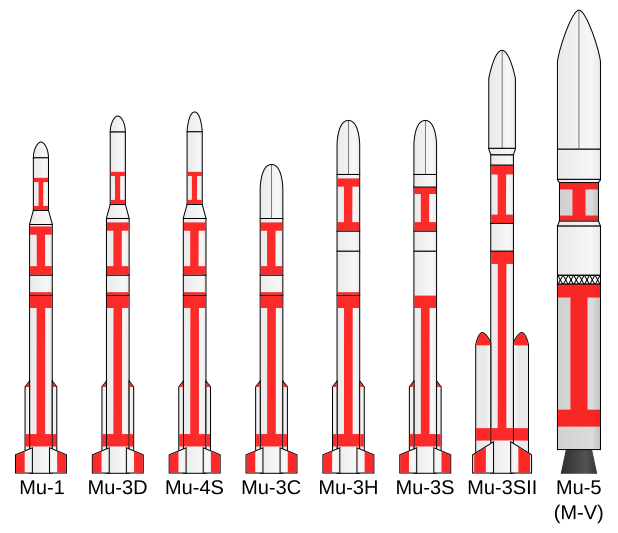The Mars program was a series of uncrewed spacecraft launched by the Soviet Union between 1960 and 1973. The spacecraft were intended to explore Mars, and included flyby probes, landers and orbiters.

An expendable launch system is a launch vehicle that can be launched only once, after which its components are either destroyed during reentry or discarded in space. ELVs typically consist of several rocket stages that are discarded sequentially as their fuel is exhausted and the vehicle gains altitude and speed. As of 2024, less and less satellites and human spacecraft are launched on ELVs in favor of reusable launch vehicles. However, there are many instances where a ELV may still have a compelling use case over a reusable vehicle. ELVs are simpler in design than reusable launch systems and therefore may have a lower production cost. Furthermore, an ELV can use its entire fuel supply to accelerate its payload, offering greater payloads. ELVs are proven technology in widespread use for many decades.

The Apollo Lunar Module, originally designated the Lunar Excursion Module (LEM), was the lunar lander spacecraft that was flown between lunar orbit and the Moon's surface during the United States' Apollo program. It was the first crewed spacecraft to operate exclusively in the airless vacuum of space, and remains the only crewed vehicle to land anywhere beyond Earth.

Nozomi was a Japanese Mars orbiter that failed to reach Mars due to electrical failure. It was constructed by the Institute of Space and Astronautical Science, University of Tokyo and launched on July 4, 1998, at 03:12 JST with an on-orbit dry mass of 258 kg and 282 kg of propellant. The Nozomi mission was terminated on December 31, 2003.

The Japan Aerospace Exploration Agency (JAXA) is the Japanese national air and space agency. Through the merger of three previously independent organizations, JAXA was formed on 1 October 2003. JAXA is responsible for research, technology development and launch of satellites into orbit, and is involved in many more advanced missions such as asteroid exploration and possible human exploration of the Moon. Its motto is One JAXA and its corporate slogan is Explore to Realize.

The M-V rocket, also called M-5 or Mu-5, was a Japanese solid-fuel rocket designed to launch scientific satellites. It was a member of the Mu family of rockets. The Institute of Space and Astronautical Science (ISAS) began developing the M-V in 1990 at a cost of 15 billion yen. It has three stages and is 30.7 m (101 ft) high, 2.5 m in diameter, and weighs about 140,000 kg (310,000 lb). It was capable of launching a satellite weighing 1,800 kg (4,000 lb) into an orbit as high as 250 km (160 mi).

The Scout family of rockets were American launch vehicles designed to place small satellites into orbit around the Earth. The Scout multistage rocket was the first orbital launch vehicle to be entirely composed of solid fuel stages. It was also the only vehicle of that type until the successful launch of the Japanese Lambda 4S in 1970.

The Uchinoura Space Center is a space launch facility in the Japanese town of Kimotsuki, Kagoshima Prefecture. Before the establishment of the JAXA space agency in 2003, it was simply called the Kagoshima Space Center (鹿児島宇宙空間観測所) (KSC). All of Japan's scientific satellites were launched from Uchinoura prior to the M-V launch vehicles being decommissioned in 2006. It continues to be used for suborbital launches, stratospheric balloons and has also been used for the Epsilon orbital launch vehicle. Additionally, the center has antennas for communication with interplanetary space probes.

S-Series is a fleet of sounding rockets funded by the Japan Aerospace Exploration Agency (JAXA) that have been in service since the late 1960s. Manufactured by IHI Aerospace and operated by the Institute of Space and Astronautical Science (ISAS). The nomenclature of the S-Series rockets is the number of "S"s indicates the number of stages, and the following number details the diameter of the craft in millimeters. For example, the S-310 is a single stage rocket with a diameter of 310 mm.

HALCA, also known for its project name VSOP, the code name MUSES-B, or just Haruka (はるか) was a Japanese 8 meter diameter radio telescope satellite which was used for Very Long Baseline Interferometry (VLBI). It was the first such space-borne dedicated VLBI mission.
Institute of Space and Astronautical Science, or ISAS, is a Japanese national research organization of astrophysics using rockets, astronomical satellites and interplanetary probes which played a major role in Japan's space development. Since 2003, it is a division of Japan Aerospace Exploration Agency (JAXA).
The J-I was a Solid-fuel rocket expendable launch vehicle developed by the National Space Development Agency of Japan and the Institute of Space and Astronautical Science. In an attempt to reduce development costs, it used the solid rocket booster from the H-II as the first stage, and the upper stages of the M-3SII. It flew only once on a suborbital flight taking place 11 February 1996 UTC from Tanegashima Space Center pad LA-N, in a partial configuration, to launch the demonstrator HYFLEX. The vehicle never flew in the final orbital capability configuration, which should have launched the OICETS satellite.

The Lambda 4S or L-4S was an experimental Japanese expendable carrier rocket. It was produced by Nissan and the Institute of Space and Astronautical Science and launched five times between 1966 and 1970 with Ohsumi technology demonstration satellites. The first four launches failed, however the fifth, launched on 11 February 1970, successfully placed Ohsumi-5, the first Japanese satellite, into orbit.

The Japanese space program originated in the mid-1950s as a research group led by Hideo Itokawa at the University of Tokyo. The size of the rockets produced gradually increased from under 30 cm (12 in) at the start of the project, to over 15 m (49 ft) by the mid-1960s. The aim of the original research project was to launch a man-made satellite.

Orbital-2, also known as Orb-2, was the third flight of the Orbital Sciences' uncrewed resupply spacecraft Cygnus, its third flight to the International Space Station, and the fourth launch of the company's Antares launch vehicle. The mission launched from the Mid-Atlantic Regional Spaceport (MARS) on 13 July 2014 at 16:52:14 UTC.

Hisaki, also known as the Spectroscopic Planet Observatory for Recognition of Interaction of Atmosphere (SPRINT-A) was a Japanese ultraviolet astronomy satellite operated by the Japan Aerospace Exploration Agency (JAXA). The first mission of the Small Scientific Satellite program, it was launched in September 2013 on the maiden flight of the Epsilon rocket. It was used for extreme ultraviolet observations of the Solar System planets.
TRICOM-1R, also known as Tasuki, was a Japanese nanosatellite that was launched during the SS-520-5 sounding rocket test launch on 3 February 2018, with a mission to conduct store and forward data relay and Earth observation using a set of cameras.

Orbiting Vehicle 1-4, launched 30 Mar 1966, was the fourth, and second successful, satellite in the OV1 series of the United States Air Force's Orbiting Vehicle program. OV1-4 was a long-term bioscience and materials science satellite, designed to return data relevant to long-term human presence in space. Its launch marked the first time two satellites were placed into orbit side by side with each other.

Orbiting Vehicle 1-7, launched 14 July 1966, was the sixth satellite launched in the OV1 series of the United States Air Force's Orbiting Vehicle program. OV1-7 was a sky science satellite, designed to return data on charged particles in orbit as well as measurements of solar X-rays and nightglow. Co-launched with OV1-8, the satellite was lost when it failed to detach from its launch rocket.

Orbiting Vehicle 1-8, launched 14 July 1966, was the seventh satellite launched in the OV1 series of the United States Air Force's Orbiting Vehicle program. OV1-8 was designed to test the passive communications utility of an aluminum grid sphere versus a balloon satellite.

















